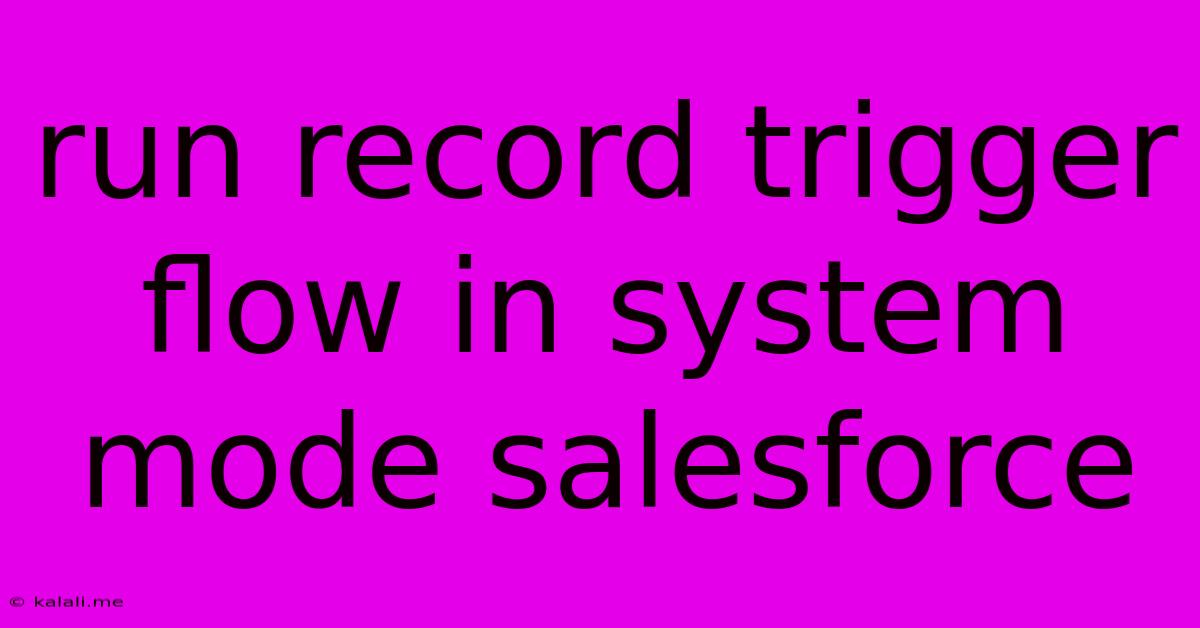Run Record Trigger Flow In System Mode Salesforce
Kalali
May 23, 2025 · 4 min read

Table of Contents
Running Record-Triggered Flows in System Mode: A Salesforce Developer's Guide
This article will delve into the intricacies of running Salesforce record-triggered flows in system mode, explaining its advantages, limitations, and best practices for implementation. Understanding this crucial aspect of flow automation is essential for developers aiming to build robust and efficient Salesforce applications. We'll cover scenarios where system mode is preferred, potential challenges, and how to troubleshoot common issues.
Record-triggered flows, a powerful feature within Salesforce, automate processes based on record creation or updates. While the default behavior is to run in user mode, choosing system mode offers distinct advantages and presents specific considerations. This article provides a comprehensive guide to navigating these nuances.
Understanding System Mode vs. User Mode
Before diving into the specifics of system mode, let's quickly recap the key difference between system and user modes for record-triggered flows:
- User Mode: The flow runs under the context of the user who initiated the record change (e.g., creating a new Account). This means the flow has access to the user's permissions and record access levels.
- System Mode: The flow runs under the system context, independent of any specific user. This grants the flow broader access to data and bypasses standard user permissions, making it ideal for tasks requiring administrative-level privileges.
Advantages of System Mode for Record-Triggered Flows
Several compelling reasons favor running record-triggered flows in system mode:
- Elevated Permissions: System mode allows access to records and data that might be restricted for regular users. This is vital when performing actions like updating records owned by other users, running Apex code that requires higher privileges, or integrating with external systems requiring broader access.
- Improved Performance: In certain cases, system mode can enhance performance, especially when dealing with complex flow logic or large datasets, as it avoids potential performance bottlenecks related to user-level permissions checks.
- Consistency and Reliability: Since system mode operates outside the constraints of user permissions, it ensures consistent behavior and predictable outcomes, regardless of who triggered the flow. This reduces the risk of errors caused by inconsistent user access.
- Automation of Admin Tasks: System mode is essential for automating tasks typically performed by system administrators, like user provisioning, data cleanup, or complex data transformations.
When to Use System Mode (and When Not To)
While powerful, system mode is not always the optimal choice. Carefully consider the following:
- Security Implications: Running flows in system mode grants extensive permissions; misuse can lead to security vulnerabilities. Thorough testing and careful consideration of access controls are crucial. Overuse of system mode should be avoided.
- Debugging Complexity: Troubleshooting errors in system mode can be slightly more challenging due to the lack of user context.
- Transaction Limits: System mode flows are still bound by Salesforce governor limits. Large-scale operations might require careful optimization to avoid hitting these limits.
Implementing and Troubleshooting Flows in System Mode
To run a record-triggered flow in system mode:
- Create or edit your flow: In the flow builder, configure your trigger settings.
- Select "System Mode": Under the "Trigger Settings" section, ensure the "Run in" option is set to "System Mode".
Troubleshooting Common Issues:
Insufficient PrivilegesErrors: Ensure the flow's assigned permission set has the necessary permissions to access the required objects and perform intended operations.- Governor Limit Exceeded: Optimize your flow logic to minimize the number of SOQL queries, DML operations, and other resource-intensive actions. Consider using bulk operations where applicable.
- Unexpected Behavior: Carefully review your flow logic for potential errors or unintended side effects. Consider using flow debugging tools to trace execution and identify the root cause.
Best Practices for System Mode Flows
- Principle of Least Privilege: Grant only the necessary permissions to your system mode flows. Avoid granting excessive access.
- Comprehensive Testing: Thoroughly test your flows in a sandbox environment before deploying them to production.
- Logging and Monitoring: Implement logging mechanisms to track flow executions and identify any potential problems.
- Regular Review: Periodically review your system mode flows to ensure they continue to meet security and performance requirements.
By carefully considering the advantages, limitations, and best practices discussed above, Salesforce developers can effectively leverage the power of system mode for record-triggered flows, creating robust and efficient automated processes within their applications. Remember, security and careful planning are paramount when working with elevated privileges.
Latest Posts
Latest Posts
-
R C Cola And A Moon Pie
Jul 04, 2025
-
If I Was 18 What Year Would I Be Born
Jul 04, 2025
-
One And Three Hundred Twenty Four Thousandths
Jul 04, 2025
-
How Much Is 2 Pounds Of Cream Cheese
Jul 04, 2025
-
How Do You Pronounce M I C H A L
Jul 04, 2025
Related Post
Thank you for visiting our website which covers about Run Record Trigger Flow In System Mode Salesforce . We hope the information provided has been useful to you. Feel free to contact us if you have any questions or need further assistance. See you next time and don't miss to bookmark.